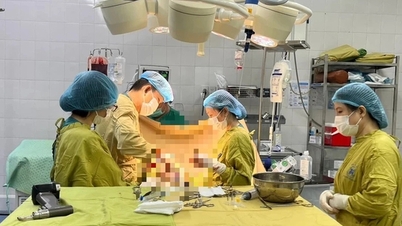Red alert hospital saves life of patient with multiple trauma shock
On December 26, Vietnam - Sweden Uong Bi Hospital (Quang Ninh) informed that with urgent emergency care and smooth coordination between specialties, the hospital's doctors had successfully saved the life of a 69-year-old patient suffering from multiple traumatic shock.
A 69-year-old patient with BTM (Phuong Nam, Uong Bi, Quang Ninh) was admitted to the hospital in a critical state of multiple trauma shock, with a blood pressure drop of 50/30mmHg. Immediately, the patient was intubated, given a ventilator, fluid replacement, emergency blood transfusion, and used vasopressors to control blood pressure. The emergency team quickly activated the hospital's "red alert" with the presence of specialists for consultation.
The patient was diagnosed with multiple trauma shock due to a traffic accident: subdural hematoma, subarachnoid hemorrhage, right lung contusion, multiple rib fractures (from ribs 1-5 on the right and 9-11 on the left), open fractures of the upper third of both tibiae on both sides, and right pelvis fracture. The doctors quickly performed emergency surgery. The surgery was performed with the participation of doctors from the Department of Neurology, Orthopedics, and Resuscitation to both resuscitate during surgery and perform surgery to stop bleeding and treat the patient's injuries.
After surgery, the patient was resuscitated and treated intensively at the hospital's Internal Intensive Care Unit. Currently, the patient's health is stable and is receiving post-operative care.
Vietnam - Sweden Uong Bi Hospital said that the hospital is the last line of the province and has been providing emergency and treatment for many cases of multiple trauma shock. The organization of the red alert emergency with the participation of many specialties took place quickly and accurately, taking advantage of the golden time in emergency, handling, and promptly saving the lives of many patients with stroke, cardiac arrest, accidents, serious injuries, etc. in the province.

The patient's health is currently stable. Photo: BVCC
What is hospital red alert?
The hospital red alert procedure is the most urgent emergency treatment, applied to emergency cases that require intervention to save the patient's life. The ultimate goal when implementing this procedure is to save the patient's life, to get the patient out of a critical condition. The hospital red alert is the highest level of emergency, allowing the hospital to mobilize all the best resources to provide emergency care in the shortest time with the ultimate goal of saving the patient's life, getting them out of a critical condition.
Previously, in the traditional emergency procedure, to perform a surgery, the patient would need to go through steps such as medical examination, clinical tests, operating room preparation, and then surgery. This process took a lot of time. Based on the above, the hospital red alert procedure was born and is considered a turning point in emergency care, increasing the chance of survival for many critically ill patients.
Situations that require the use of the red alert procedure include:
1. Accidents and injuries: critical condition, obstetric complications, etc.
2. Pathological emergency: indication for intervention or urgent medication
– Ischemic stroke with indication for thrombolytic drugs
– Myocardial infarction with indication for reperfusion intervention…
3. Emergency care for inpatients with sudden deterioration that threatens their lives.
The red alert process is built on the basis of disease models, technical expertise, depending on the actual conditions of each hospital and is authorized to the head doctor of the emergency team where the patient is initially admitted to activate the internal red alert process.
The emergency physician and the surgeon on duty are authorized to “send the red signal” without having to wait for the opinion of the department head or the hospital leader on duty, if they assess that emergency surgery is needed. The doctors in the process are always on call 24/7. When receiving the alarm signal, regardless of the time, location, or lengthy questions about the patient’s hospitalization status, they must immediately be present in the operating room.
The advantage of the red alert procedure is that the medical service mobilizes many departments, concentrates equipment and techniques to save the patient in an extremely short time. Instead of the fastest time of about 30 minutes as in the normal procedure, the "red alert" only needs 5-10 minutes to move the patient from the emergency room to the operating room.


![[Photo] "Lovely" moments on the 30/4 holiday](https://vphoto.vietnam.vn/thumb/1200x675/vietnam/resource/IMAGE/2025/5/1/26d5d698f36b498287397db9e2f9d16c)
![[Photo] Ha Giang: Many key projects under construction during the holiday season](https://vphoto.vietnam.vn/thumb/1200x675/vietnam/resource/IMAGE/2025/5/1/8b8d87a9bd9b4d279bf5c1f71c030dec)



![[Photo] Binh Thuan organizes many special festivals on the occasion of April 30 and May 1](https://vphoto.vietnam.vn/thumb/1200x675/vietnam/resource/IMAGE/2025/5/1/5180af1d979642468ef6a3a9755d8d51)






























































































Comment (0)